KNI is Now Drilling for Cobalt in the EU - Three EM Targets to Aim For
Disclosure: S3 Consortium Pty Ltd (The Company) and Associated Entities own 2,739,750 KNI shares and the Company’s staff own 7,500 KNI shares at the time of publishing this article. The Company has been engaged by KNI to share our commentary on the progress of our Investment in KNI over time.
Just last week our battery metals exploration investment, Kuniko (ASX:KNI) commenced drilling at three of its highest priority cobalt targets in Norway.
Using a diamond drill rig, KNI has just started a 2,800m drilling program across 7 different holes at three of its highest priority cobalt targets.
These three targets came together after KNI applied modern exploration techniques (geophysical / geochemical works) across its Norwegian cobalt project.
Importantly, all three of these anomalies sit in and around the old workings of a historic cobalt mine. This mine produced over 1 million tonnes of cobalt ore, making it the world's largest cobalt producing mine in its day.
With drilling already started, as we do with all of our exploration investments, we have set some expectations for the drilling results. These will be used as a benchmark to evaluate how KNI did with this drilling program.
Our expectations in its most simple format are as follows:
- Bullish case = Several intercepts with cobalt grades ranging between 0.5-1%.
- Base case = At least once intercept with cobalt grades around 0.5%.
- Bearish case = No mineralisation found in any of the drillholes.
We will cover these expectations later in this article.
Just before the drilling program, KNI secured $8M via a placement @ $1 per share, with the shares from the placement being issued last Friday.
The raise was oversubscribed, and cornerstoned by prominent mining investor John Hancock. KNI also attracted a number of Australian and offshore investors to the placement. KNI’s directors committed to taking $315,000 in placement shares. We also Invested in this placement.
Concurrently, the company has launched a Share Purchase Plan to raise a further $2M at the same price of $1 per share.
KNI is currently trading below this level, closing at 88c last Friday, that’s 12% below the capital raise price.
With heightened geopolitical tensions impacting global supply chains, we think KNI is well placed to benefit from a push to localise these supply chains.
A new discovery at its cobalt project could potentially put this whole region back on the map as a potential supplier of cobalt into the key EU markets.
Located in Norway, KNI’s project is on the doorstep of some of the world’s largest automakers like VW and Daimler (Mercedes) - almost all of which have made long term commitments to electrifying their car fleets.
Demand for EVs is so high that VW sold out of them and it has around 300,000 orders in backlog in western Europe.
In this environment, cobalt has never been more important as a battery metal.
Cobalt is one of the key raw materials used in the production of lithium-ion batteries accounting for ~60% of global consumption.
This means that the electric vehicle (EV) revolution is heavily dependent on ensuring that there is a secure supply of this valuable raw material.
At the moment ~70% of global supply comes out of the Democratic Republic of Congo, and is almost exclusively exported to China for further refining. This means that Western economies don't have a grip on the cobalt supply chain.
Europe currently imports ~86% of all of its cobalt needs and less than 1.5% of global cobalt production is located domestically in the EU.
Recognising this, cobalt has made its way onto the critical minerals list for just about every western economy from the EU, USA, Japan to India and Australia.
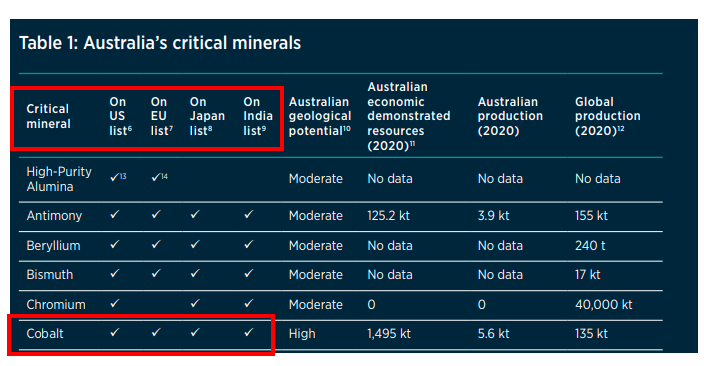
As the world scrambles to secure its supply chain of these critical raw materials, our battery metals investment KNI is taking its first shot at making a potentially regionally significant discovery, INSIDE the EU, right now.
We set this current drilling program as key objective #2 of our 2022 KNI Investment memo. And with the drilling program expected to be completed at some stage in June, we expect to start seeing the preliminary results before the end of Q3 or in early Q4 of this year.
Below is an excerpt of all the key objectives we set for what we wanted to see KNI achieve in 2022. Click on the image to view our full Investment Memo.
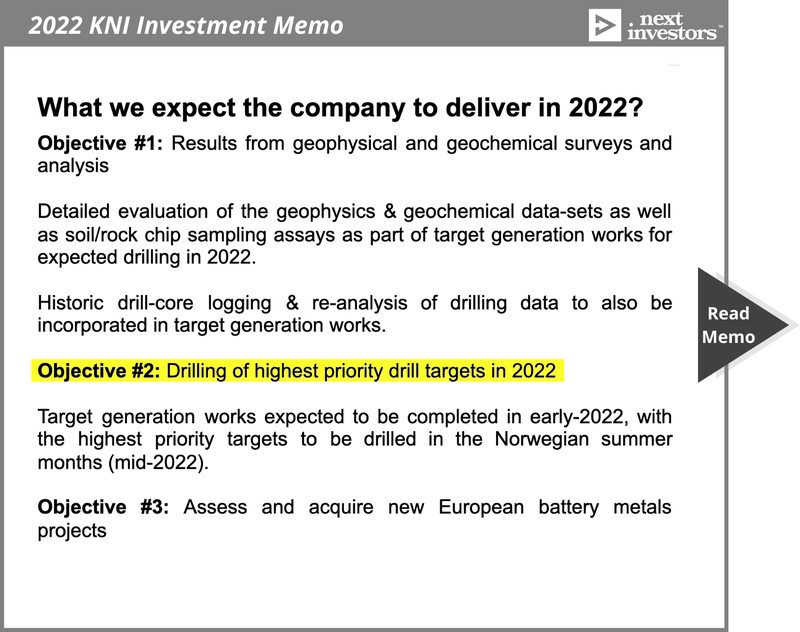
What do we want to see from the drilling program?
2,800m drilling program across 7 different holes 🔄
Drilling is ongoing and expected to be completed in June.
Based on the usual time it takes companies to announce drilling assays, we predict that the assays will take ~8-12 weeks after the drilling program is completed so we don't expect any of the results to be announced until the middle of or closer to the end of the June quarter.
As we have done with our other exploration Investments, we have decided to set up our expectations ahead of the results coming to market.
🎓 = To learn more about how we go about setting our expectations for drilling events check out our educational article here.
Below are our expectations for KNI’s drilling program:
1 - Bullish case (exceptional result):
For this round of drilling, we think that an exceptional result will be if KNI can identify several mineralised intercepts and then for the assays from these intercepts to return cobalt grades above 0.5-1%.
If we see grades above 1% then the results will be significantly better than we expected.
Why are we using 0.5% as a grade benchmark?
This largely has to do with the cobalt price. With the spot price for cobalt trading near all time highs of US$82,000 per tonne, a cobalt miner doesn't need a lot of cobalt to generate significant revenues.
For example, selling 1kg of iron ore would generate revenues of US$0.13 whereas selling 1kg of cobalt would generate revenues of US$82.
For some context one of the world's biggest cobalt mines, Glencore’s Kamoto copper-cobalt mine in the DRC, had a resource measuring 77.7Mt with cobalt grades of ~0.48% cobalt.
Mines like this have been in operation when cobalt prices were much lower, so it would be safe to assume that discovery could be considered economic at today’s prices at lower cobalt grades. However, using a long term average price for cobalt, we think that the 0.5% grade is a good benchmark.
🎓 = To learn more about how grades for economic discoveries are calculated check out our educational article here.
2 - Base case (good result):
Our base case for the drilling program is simply for KNI to make at least one mineralised intersection and then for the assays to return cobalt grading above 0.5%.
3 - Bearish case (poor result):
The worst case scenario here would be that the EM anomalies represent no mineralisation of significance and there is no information that warrants follow up exploration across these high priority targets.
In this case, KNI would need to go back to the drawing board to try and put together a new list of targets for future exploration programs.
This can happen in early stage exploration, something we are always mindful of as investors in small cap exploration stocks.
KNI had $4.9M in cash in the bank at the end of the last quarter, $8M raised via the placement and is looking to raise another $2M through the SPP, so KNI could potentially end up with a bank balance of ~$15M (assuming the SPP is taken up in full).
KNI has a few other projects (copper, nickel and lithium) that it is also preparing for upcoming drilling.
And with that much cash in the bank, KNI will still have plenty of capital to run follow up drilling programs to try and make a new discovery in the event this current drill campaign fails.
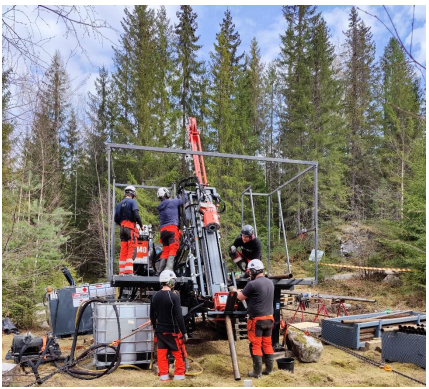
Geochemical works ongoing 🔄
KNI also confirmed in the announcement early last week that its exploration team was doing some additional geochemical sampling works to put together better drill targets.
Given the KNI team is already on the ground, the proactive exploration is a positive and more drill targets is always a positive.
More on the cobalt targets KNI is drilling
One of the key reasons for our KNI Investment comes from the company’s projects being unexplored by modern exploration technologies.
With its projects located in a part of Norway that was home to a historic mine that was the biggest in the world back when it was operating, we believed that with modern geophysics and geochemical technologies KNI could unlock a new discovery that was missed in the past.
After running rounds of geophysical surveys and some geochemical studies, KNI has put together three independent high priority drilling targets in and around that historic mine.
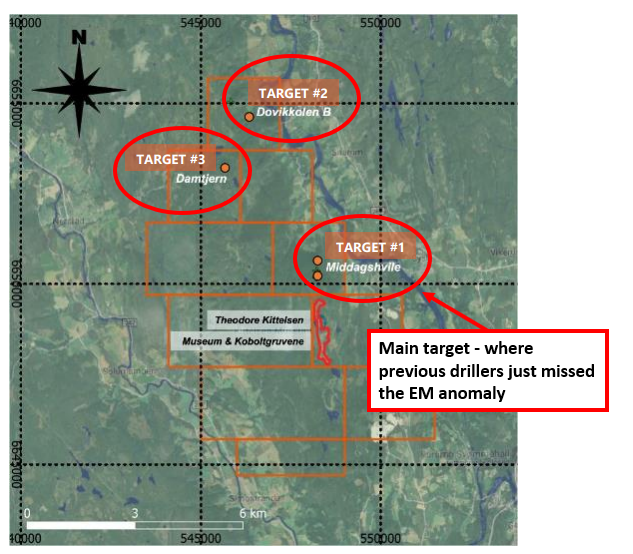
Below we will do a deep dive into these three key targets.
Target 1: Massive EM anomaly right next to where previous drilling missed
The first target (“Middagshville”) is the massive EM anomaly found right next to where the previous owners of the project (Berkut Minerals) had done some drilling in 2018... but completely missed it.
Berkut at the time was drilling “blind” - designing its drilling program purely based on soil sampling results.
Effectively, Berkut simply took some soil samples, and decided to drill beneath where they picked them up, without any modern geophysics, geochemistry or EM surveying to assist with target selection - which explains why the company could have come so close and moved on from the project.
KNI has done all of that work, applying as much modern exploration technology as possible. KNI has taken all of the data Berkut gathered, overlaid its EM, geophysics and geochemistry data to get a much better idea of where it needs to drill to test the large anomaly that Berkut just missed.
The image below shows how Berkut’s drilling fell short of hitting the anomaly with one drillhole, and fell behind/in front of the anomaly with other drill holes.
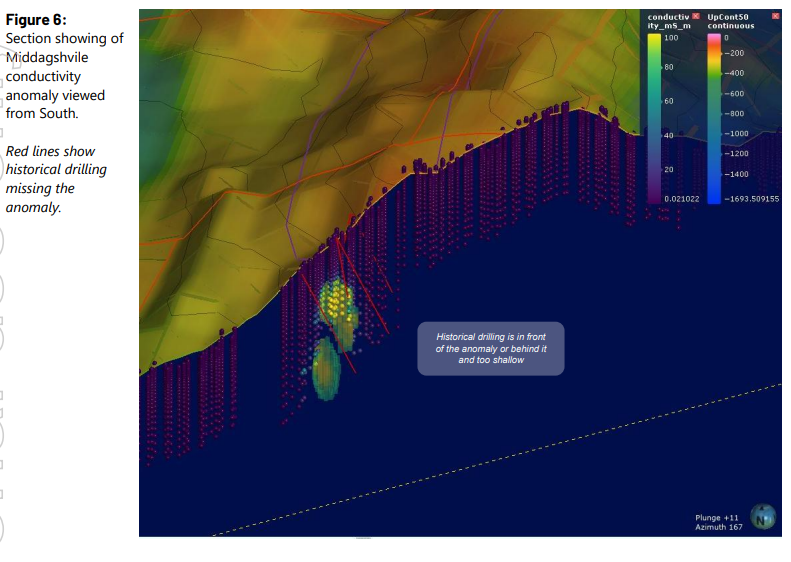
The image below also shows how much clearer KNI has managed to model the EM anomalies, leading up to this round of drilling:
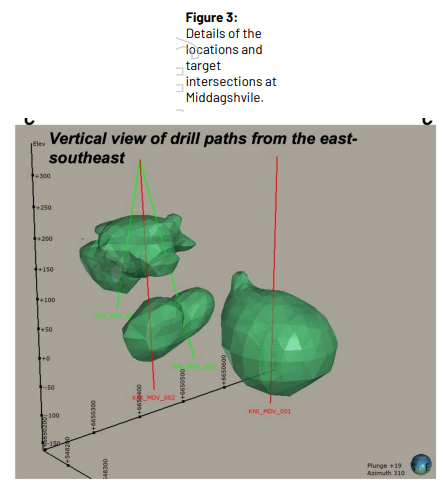
Targets 2 and 3: Two new targets generated by geophysics
KNI managed to add two additional high priority drill-targets after running some ‘advanced interpretive analytical’ work or in simpler language, high-tech desktop studies have opened up 2 new geophysics targets.
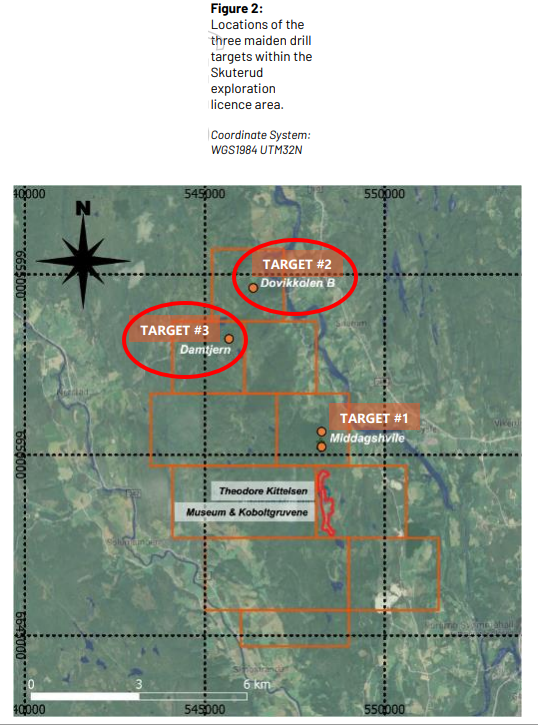
These targets sit within a ~6km radius of the company’s highest priority target at the “Middagshville'' prospect. Importantly, both of these new targets have been put together using an almost identical approach to the main “Middagshville target”.
Below is an image of the modelling KNI did across both of these targets, again using all the same modern exploration technologies used to refine the Middaghsville target.
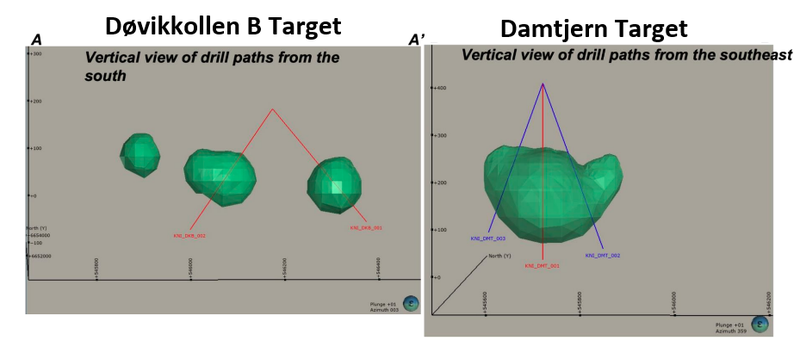
These two will also be drill tested as part of the current 2,800m, 7-hole diamond drilling program alongside the main “Middaghsville” prospect.
More on the capital raise:
For those who missed the launch of our new feature on the Nextinvestors.com website, we recently launched a “Quick Takes” page where we cover all of the latest announcements from our Portfolio companies and any macro news that we think is relevant.
We covered the KNI capital raise via a Quick Take which you can view here: Kuniko raises A$8M, drilling commenced.
To see our take LIVE on everything related to our portfolio companies bookmark the page and check in for the posts which we publish on a daily basis.
Here is the link to the Quick Takes page: https://nextinvestors.com/quick-takes/
As for KNI’s capital raise, KNI raised $8M via a placement @ $1 per share, with the shares all issued last Friday.
We think the $8M placement completed right before drilling started is a prudent move by the company, given the outcome of the drilling program is exploration risk in its purest form.
Results can fall on a spectrum, between outstanding and disappointing - and everything in between - as we covered above.
The $8M will add to the already healthy cash balance the company had of $4.8M at the end of the March quarter, meaning the company will be well funded through the current round of drilling and for any follow up exploration required.
We have a general rule that we like to see our junior exploration companies follow, where they hold a minimum of ~10% of their market cap in cash. KNI should now have ~$13M in the bank which surpasses this 10% rule given the market cap is currently ~$56M.
Some of the highlights from the placement for us were the following:
- KNI received a cornerstone investment from existing shareholder and high-profile mining investor, Mr John Hancock.
- KNI also mentioned that several other domestic and offshore institutional investors participated in the raise and are now KNI shareholders.
- KNI’s directors also subscribed for $315k in shares via the placement. These shares are subject to shareholder approvals though and were not issued last Friday. With the general meeting scheduled for the 31st of May, the directors won't receive their shares until after this shareholder vote which will coincide with the conclusion of the drilling program.
At the same time as the placement, KNI also launched a Share Purchase Plan (SPP) which is looking to raise a further $2M with the following key dates:
- Record date: 29 April 2022
- Closing date: 27 May 2022
- Issue date: 1 June 2022 (just in time for the completion of the drilling program which KNI confirmed would be some time in June).
This means that those who were holding KNI shares at the close of market on 29 April will be eligible to bid for a maximum of $30,000 in new shares, on the same terms and conditions as the placement.
At the moment the KNI share price is trading slightly below the capital raise price, but we suspect that as we get closer to the conclusion of the drilling program the share price may start to trade at a premium.
So we see the SPP as essentially a “free option” for existing holders on being able to acquire KNI shares at $1 if the share price runs above $1 into the drilling program.
Our 2022 KNI Investment Memo:
Below is our 2022 Investment Memo for KNI where you can find a short, high level summary of our reasons for investing.
The ultimate purpose of the memo is to track the progress of our portfolio companies using our Investment Memo as a benchmark, throughout 2022.
In our KNI Investment Memo you’ll find:
- Key objectives for KNI in 2022
- Why we continue to hold KNI
- What the key risks to our investment thesis are
- Our investment plan
General Information Only
This material has been prepared by StocksDigital. StocksDigital is an authorised representative (CAR 000433913) of 62 Consulting Pty Limited (ABN 88 664 809 303) (AFSL 548573).
This material is general advice only and is not an offer for the purchase or sale of any financial product or service. The material is not intended to provide you with personal financial or tax advice and does not take into account your personal objectives, financial situation or needs. Although we believe that the material is correct, no warranty of accuracy, reliability or completeness is given, except for liability under statute which cannot be excluded. Please note that past performance may not be indicative of future performance and that no guarantee of performance, the return of capital or a particular rate of return is given by 62C, StocksDigital, any of their related body corporates or any other person. To the maximum extent possible, 62C, StocksDigital, their related body corporates or any other person do not accept any liability for any statement in this material.
Conflicts of Interest Notice
S3 and its associated entities may hold investments in companies featured in its articles, including through being paid in the securities of the companies we provide commentary on. We disclose the securities held in relation to a particular company that we provide commentary on. Refer to our Disclosure Policy for information on our self-imposed trading blackouts, hold conditions and de-risking (sell conditions) which seek to mitigate against any potential conflicts of interest.
Publication Notice and Disclaimer
The information contained in this article is current as at the publication date. At the time of publishing, the information contained in this article is based on sources which are available in the public domain that we consider to be reliable, and our own analysis of those sources. The views of the author may not reflect the views of the AFSL holder. Any decision by you to purchase securities in the companies featured in this article should be done so after you have sought your own independent professional advice regarding this information and made your own inquiries as to the validity of any information in this article.
Any forward-looking statements contained in this article are not guarantees or predictions of future performance, and involve known and unknown risks, uncertainties and other factors, many of which are beyond our control, and which may cause actual results or performance of companies featured to differ materially from those expressed in the statements contained in this article. S3 cannot and does not give any assurance that the results or performance expressed or implied by any forward-looking statements contained in this article will actually occur and readers are cautioned not to put undue reliance on forward-looking statements.
This article may include references to our past investing performance. Past performance is not a reliable indicator of our future investing performance.

